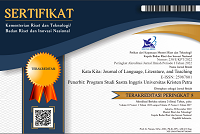Translation Strategies for Indonesian Version of The Adventure of Tintin Land of Black Gold
(1) Petra Christian University
(*) Corresponding Author
Abstract
Keywords
Full Text:
PDFReferences
Baker, M. (2018). In other words: A coursebook on translation (3rd ed.). Routledge (3rd ed.).
Cholliludin. (2005). The technique of making idiomatic translation. Kesaint blanc.
Dasha. (2021, October 29). Text bubbles: A big guide. https://shorturl.at/jotxG
Folleti, N. (2022, January 31). Translating comic books: A very particular challenge. https://www.wabbit-translations.com/en/translating-comic-books/
Gaiman, N. (2021, August 10). How to create a comic book: Neil gaiman’s step-by-step guide for making comics. https://www.masterclass.com/articles/how-to-create-a-comic-book-step-by-step-guide-for-making-your-own-comics
Hergé. (2012). Petualangan Tintin: Tintin di Negeri Emas Hitam (Vol. 13). Kompas Gramedia. Jakarta
Hergé. (1972). The Adventure of Tintin: Land of Black Gold (Third, Vol. 18). Magnet. North Yorkshire
Molina, L., & Hurtado Albir, A. (2002). Translation techniques revisited: A dynamic and functionalist approach. Meta: Journal des Traducteurs/Meta: Translators' Journal, 47(4), 498-512.
Munday, J., & Hatim, B. H. (2004). Translation: An advanced resource book. Routledge.
Newmark, P. (1988). A textbook of translation. Prentice-Hall International.
Tintinimaginatio. (2023). Tintin. www.tintin.com/en
Udayani, N. K. R. T. K., Wibawa, I. M. C., & Rati, N. W. (2021). Development of e-Comic learning media on the topic of the human digestive system. https://ejournal.undiksha.ac.id/index.php/JET/article/view/34732/19556
Ying Cui., & Zhao, W. (2014). Handbook of Research on Teaching Methods in Language Translation and Interpretation. Shandong University.
DOI: https://doi.org/10.9744/katakita.11.2.206-214
Refbacks
- There are currently no refbacks.
Supported by:
Indexed in:
Tools:
Stats (installed since 17 December 2018)
View My Stats













